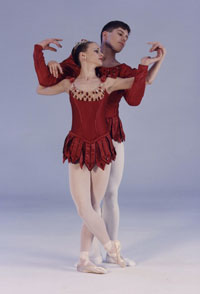
Choreography: George Balanchine
Music: Igor Stravinsky
Jewels, a work in three parts choreographed by George Balanchine, had a forerunner in the first production of Balanchine’s Symphony in Cat the Paris Opera in 1947. In it, each movement of the ballet, then called Le Palais de Cristal, was costumed in a different jewel color. Taking up this concept again, Balanchine selected emeralds, rubies, and diamonds for his parure (a matched set of jewelry), having also considered pearls and sapphires. But Jewels is really not so much about gems as about facets of classical dancing. And while it has been considered the first three-act story-less ballet, the jewel motif, sustained by Karinska’s costumes and the decor, is actually a device to unify sections that would otherwise be disparate. Each act is quite distinct in style and has music by a different composer: Faure for Emeralds, Stravinsky for Rubies, Tchaikovsky for Diamonds.
Balanchine was inspired by the artistry of jewelry designer Claude Arpels, and chose music revealing the essence of each jewel. He explained: “Of course, I have always liked jewels; after all, I am an Oriental, from Georgia in the Caucasus. I like the color of gems, the beauty of stones, and it was wonderful to see how our costume workshop, under Karinska’s direction, came so close to the quality of real stones (which were of course too heavy for the dancers to wear!)”
Each section of the ballet is distinct in both mood and music. Emeralds, which Balanchine considered “an evocation of France – the France of elegance, comfort, dress, [and] perfume,” recalls the 19th century dances of the French Romantics. Rubies is crisp and witty, epitomizing the collaboration of Stravinsky and Balanchine. Diamonds recalls the order and grandeur of Imperial Russia and the Maryinsky Theater, where Balanchine was trained.
Igor Stravinsky composed his three-movement Capricio for Piano and Orchestra, the music for Rubies, in 1928-29. He intended it as a vehicle for his own appearances as a concert pianist and as something of a relief from his Concerto for Piano and Wind Instruments, which he had written five years before for the same purpose. The Capriccio is, in effect, a second piano concerto. Stravinsky said that as he wrote this score he had in mind Carl Maria von Weber, a composer he championed: in fact, he quotes Weber in the music. Another of Stravinsky’s enthusiasms that affects the Capriccio is the cimbalom. Figurations typical of this east European instrument are the evidence at various places in the solo piano part – in certain repeated notes and in the cadenza in the second movement, for example. Balanchine set the second movement as a pas de deux for the principal dancers, and they and a soloist dance with the corps de ballet in various combinations in the outer movements.
